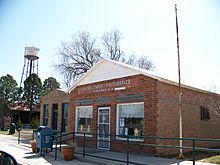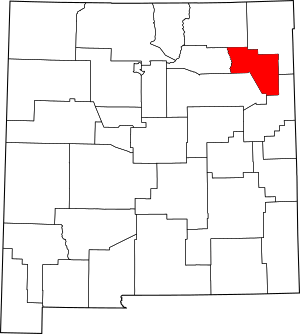Harding County, New Mexico facts for kids
Quick facts for kids
Harding County
|
|
|---|---|

Mosquero post office
|
|

Location within the U.S. state of New Mexico
|
|
 New Mexico's location within the U.S. |
|
| Country | |
| State | |
| Founded | March 4, 1921 |
| Named for | Warren G. Harding |
| Seat | Mosquero |
| Largest village | Roy |
| Area | |
| • Total | 2,126 sq mi (5,510 km2) |
| • Land | 2,125 sq mi (5,500 km2) |
| • Water | 0.4 sq mi (1 km2) 0.02%% |
| Population
(2020)
|
|
| • Total | 657 |
| • Density | 0.30903/sq mi (0.11932/km2) |
| Time zone | UTC−7 (Mountain) |
| • Summer (DST) | UTC−6 (MDT) |
| Congressional district | 3rd |
Harding County is a county in the U.S. state of New Mexico. As of the 2020 census, the population was 657, making it the least populous county in the state, and the 13th-smallest county by population in the United States. Its county seat is Mosquero. The county is named for United States President Warren G. Harding, and was created (from parts of Union and Mora Counties) on the day of his inauguration as president on March 4, 1921, making him the most recent president to have a county in any state named after him.
The only incorporated cities in Harding County are Roy and Mosquero.
Contents
Geography
According to the U.S. Census Bureau, the county has a total area of 2,126 square miles (5,510 km2), of which 2,125 square miles (5,500 km2) is land and 0.4 square miles (1.0 km2) (0.02%) is water. It is divided between a high, nearly treeless prairie to the northwest (the southern limit of the High Plains), and a lower semi-desert rangeland to the southeast, by the eastern portion of the steep Canadian Escarpment. The Canadian River, in a deep and narrow canyon, forms the western border with Mora County; the southwest border runs along the edge of the Bell Ranch land in San Miguel County. The eastern part of Harding County is underlain in part by the Bravo Dome carbon dioxide gas field, which is commercially extracted.
Adjacent counties
- Union County – northeast
- Quay County – southeast
- San Miguel County – south
- Mora County – west
- Colfax County – northwest
National protected area
- Kiowa National Grassland (part)
Demographics
| Historical population | |||
|---|---|---|---|
| Census | Pop. | %± | |
| 1930 | 4,421 | — | |
| 1940 | 4,374 | −1.1% | |
| 1950 | 3,013 | −31.1% | |
| 1960 | 1,874 | −37.8% | |
| 1970 | 1,348 | −28.1% | |
| 1980 | 1,090 | −19.1% | |
| 1990 | 987 | −9.4% | |
| 2000 | 810 | −17.9% | |
| 2010 | 695 | −14.2% | |
| 2020 | 657 | −5.5% | |
| U.S. Decennial Census 1790-1960 1900-1990 1990-2000 2010 |
|||
2010 census
As of the 2010 census, there were 695 people, 349 households, and 213 families living in the county. The population density was 0.3 inhabitants per square mile (0.12 inhabitants/km2). There were 526 housing units at an average density of 0.2 units per square mile (0.077 units/km2). The racial makeup of the county was 86.9% white, 1.2% American Indian, 0.3% black or African American, 10.2% from other races, and 1.4% from two or more races. Those of Hispanic or Latino origin made up 43.0% of the population. In terms of ancestry, 11.0% were German, and 2.2% were American.
Of the 349 households, 15.5% had children under the age of 18 living with them, 51.3% were married couples living together, 5.4% had a female householder with no husband present, 39.0% were non-families, and 34.7% of all households were made up of individuals. The average household size was 1.99 and the average family size was 2.49. The median age was 55.9 years.
The median income for a household in the county was $33,750 and the median income for a family was $56,563. Males had a median income of $36,167 versus $29,111 for females. The per capita income for the county was $14,684. About 9.1% of families and 19.1% of the population were below the poverty line, including 11.6% of those under age 18 and 24.7% of those age 65 or over.
Communities
Villages
Unincorporated communities
See also
 In Spanish: Condado de Harding (Nuevo México) para niños
In Spanish: Condado de Harding (Nuevo México) para niños

